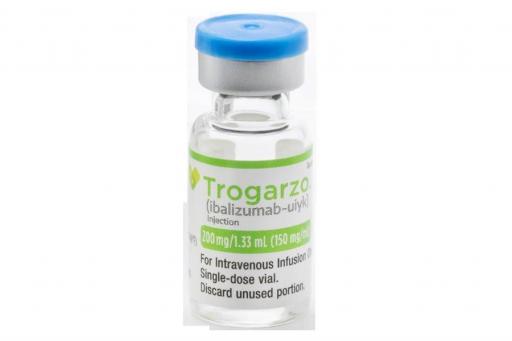Trogarzo
ibalizumab-uiyk IBA (long-acting EI)

Standard Dose
Long-acting antiretroviral administered once every two weeks via intravenous infusion. Treatment begins with a single loading (starting) dose of 2,000 mg, followed by an 800 mg maintenance dose given every two weeks thereafter. Trogarzo can be administered as a diluted intravenous (IV) infusion or undiluted IV push. Must be taken in combination with another antiretroviral(s).The first dose takes 90 seconds if pushed or at least 30 minutes if infused. If no infusion-related adverse events occur, subsequent doses can be given as an IV push over 30 seconds or as an IV infusion over 15 minutes. Doses may be administered every two weeks at an inpatient and/or outpatient setting, including at-home infusion, if desired. All patients should be observed for 1 hour after receiving their first dose. If no administration-associated adverse reaction is noted, the post-administration observation time can be reduced to 15 minutes for subsequent doses.
For the IV push: The undiluted solution should be administered immediately. Trogarzo should be administered in the cephalic vein of the patient's arm. For the IV infusion: Once diluted, the Trogarzo solution should be administered immediately. If not administered immediately, store at room temperature for up to 4 hours or refrigerated for up to 24 hours. If refrigerated, allow diluted solution to stand at room temperature for at least 30 minutes, but no more than 4 hours, prior to administration.
Trogarzo must be given with an optimized background regimen (OBR). An OBR consists of the best antiretroviral therapy that can be selected for a person based on the patterns of HIV drug resistance of their virus. Other considerations can include safety profile, tolerability, and lack of adverse drug-drug interactions or cross-resistance. Dose modifications of Trogarzo are not required when administered with any other antiretroviral or any other treatments.
If a maintenance dose of Trogarzo is missed by 3 days or longer beyond the scheduled dosing day, a loading dose (2,000 mg) should be administered as soon as possible. Then maintenance dosing (800 mg) can be resumed every 14 days thereafter.
- See package insert for more complete information on potential side effects and interactions.
Manufacturer
TaiMed USADistributed by
Theratechnologies Inc.
theratech.com; trogarzo.com
AWP
$3,435.60 per box (2 vials); 10 vials for loading dose and four vials for continuing dose (every two weeks)Potential Side Effects and Toxicity
The most common adverse reactions observed in clinical studies were diarrhea (8%), dizziness (8%), nausea (5%), and rash (5%). Select lab abnormalities noted to occur in at least 5% of studied patients were increased bilirubin by greater than 2.6 times ULN (upper limit of normal), 5%; increased creatinine (greater than 1.8 times ULN or 1.5x baseline), 10%; increased lipase (greater than 3 times ULN), 5%; decreased leukocytes, 5%; and decreased neutrophils, 5%. Most (90%) of the adverse reactions reported were mild or moderate in severity. No formal studies were conducted to examine the effects of either renal or hepatic impairment on the pharmacokinetics of Trogarzo. Renal impairment is not anticipated to affect the pharmacokinetics of Trogarzo. Based on animal data using higher doses of medication than would be used in humans, the FDA updated the drug label in 2021 to include the potential for transient immunosuppression in infants exposed to the drug inside the womb. See Section 8.1 (Pregnancy) in the prescribing information for more details.
Potential Drug Interactions
Based on Trogarzo’s mechanism of action and pharmacokinetic profile, drug-drug interactions are not expected. No formal drug interaction studies have been conducted with Trogarzo.
More Information
The FDA approval is for heavily treatment-experienced (HTE) individuals with resistance to multiple HIV drug classes, in combination with an optimized background regimen (OBR), for people who are failing their current regimen. GO TO bit.ly/Trogarzo-mechanism-of-action to watch a YouTube video of its mechanism of action. A key point is that people must still take other HIV medications that have some activity—there has to be at least one HIV drug to which their virus is sensitive included in their OBR. Trogarzo is a newer option, but it does come with some rules. Non-adherence won’t be an option—people won’t be able to just show up whenever they want or be late to appointments when going to a doctor’s office or an infusion center. People must be on time. It is expensive because of the cost of the drug in addition to other expenses such as the time at the infusion center and cost for qualified individuals to administer and handle the medication, although there may be an option for people to receive their infusion at home. Infusions can also be done at clinics and at IV centers. The undiluted IV push dosing requires less time and supplies to administer.
Other long-acting HIV drugs are on the way and may be studied in combination with Trogarzo as well. Sunlenca (see that drug page) has been approved for heavily treatment-experienced people and can be combined with Trogarzo. Trogarzo is also the first HIV orphan drug—one that is produced for a relatively small population of people, fewer than 200,000. It was produced for people with multidrug-resistant HIV, estimated by the company to be fewer than 25,000. These are heavily treatment-experienced people who have multidrug resistance, and have, therefore, limited treatment options. Trogarzo has been shown to work against highly drug-resistant virus, when combined with an OBR. Data presented at ID Week 2020 showed evidence for long-term safety and efficacy as well as tolerability in people receiving Trogarzo for almost a decade. Trogarzo has also demonstrated CD4 improvements in clinical studies.
Trogarzo is neither metabolized in the liver nor eliminated by the kidneys. Monoclonal antibodies such as ibalizumab are transported across the placenta as pregnancy progresses; therefore, the developing fetus has the potential to be exposed to Trogarzo. Pregnant individuals can voluntarily enroll in the Antiretroviral Pregnancy Registry through their provider; GO TO apregistry.com.
Thera Patient Support can assist with private or government insurance coverage, including AIDS Drug Assistance Programs (ADAPs), and will also assist in applying any eligible co‑pay assistance. Commercially insured people may be eligible for co-pay assistance and may pay as little as $0. Call (833) 23-THERA (833-238-4372), or GO TO therapatientsupport.com.
Doctor Comments
Dr. Melanie Thompson:
Ibalizumab is a “post-attachment” inhibitor that stops HIV from entering the CD4 cell. It is only used for people with multi-drug resistant HIV who cannot otherwise construct a viable regimen. It requires intravenous (IV) infusions or IV push every 2 weeks. There is preliminary evidence (presented in a poster at CROI 2024) that intramuscular (in the muscle) dosing may also work, although Trogarzo is not FDA approved in this manner. It is the most expensive antiretroviral drug ever approved, with administration costs not included. The pricing is accompanied by a patient assistance program that intends to shield individuals—but not the healthcare system—from much of the financial burden. Trogarzo has no known drug-drug interactions.
Activist Comments
Activist Joey Wynn:
Ibalizumab is the first drug in a new class called CD4-directed post-attachment inhibitors. It blocks the virus from entering CD4 cells; for use only in highly treatment-experienced people, meaning they have no other realistic options. More convenient oral or injectable HIV drugs are in development for highly treatment-experienced people, but until those drugs are approved. Trogarzo remains a vital lifeline for them to buy time until the next new option.


